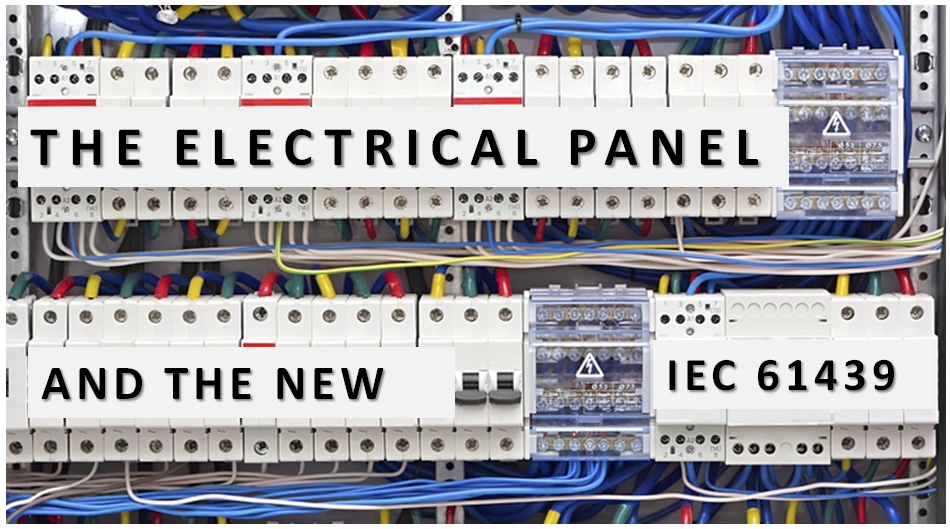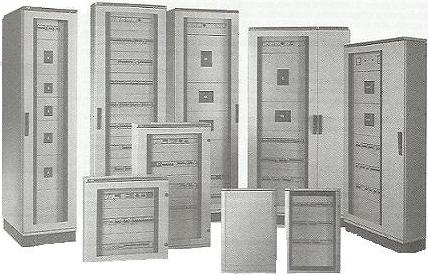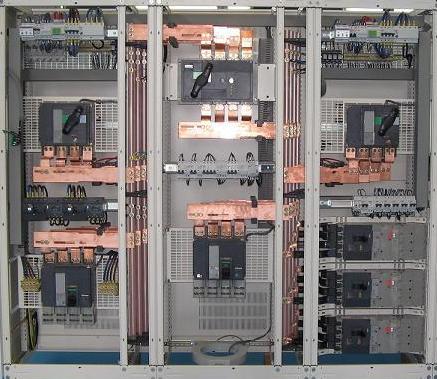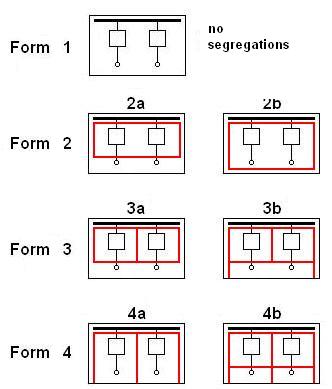Introduction
Only a few months to November 1, 2014, the date when the Standard IEC 60439-1 (for low voltage switchboards) will be permanently repealed, and replaced by the new IEC 61439-1 and 61439-2. With these new rules the structure of the regulatory frameworks has been completely changed. In fact, with the old structure of the 60439, each sub-standard is fully autonomous.
For example, if you need to design an electrical panel in a construction site, it is sufficient to comply with the 60439-4 standard which includes general specifications. With the new structure 61439, however, the IEC 61439-1 assumes the role of “parent”, which establishes the general rules to be considered only as reference standard for all subsequent “children” standards about a particular type of panel. This means that compliance with the standards of an electrical panel will take at least two standards; the IEC 61439-1 plus one of the following relating to the type the electric panel to be realized, for example, IEC 61439-2 for power panels.
The new standard IEC 61439 is structured as follows:
- 61439-1 mandatory services valid for all types of low voltage electrical panel;
- 61439-2 standards for power panels;
- 61439-3 standards for final distribution switchboards;
- 61439-4 standards for electrical panels in a construction site;
- 61439-5 standards for power distribution switchboards;
- 61439-6 standards for busbar systems.
The electrical panel
The new 61439 series of standards consider the electrical panel as an electrical component more or less complex consisting of:
- mechanical parts constitute a container called case with the function of support and protection of all the equipment contained inside it (see Fig. 1);
- electrical equipment consisting of internal equipment of command and / or protection and / or switching and / or control with the relative connections and terminal blocks of input and output (see Fig. 2);
- segregations are internal divisions using diaphragms or insulating barriers, appropriately classified in accordance with the seven forms (See 1, 2a, 2b, 3a, 3b, 4a, 4b in Fig. 3), which allow you to perform actions on the part of the picture, while keeping the adjacent parts in tension or implement adequate protection against internal arcs due to failure of the insulation.
The panel is an electrical component which performs the tasks of command, operation, control and protection. It is responsible for the interface between the point of delivery of the National Distributor and the entire electrical installation. For AC voltages up to 1000 V and DC voltages up to 1500 V, the 61439-1 standard defines several categories of electrical panels in accordance with the following factors:
1. Construction Type:
・Closed panel, consisting of a cabinet completely protected on all sides by direct contact with minimum degree of protection IPXXB. It must be used for installation in ordinary environments;
・Open panel, consisting of a cabinet without frontal protection with the possibility of access to live parts. It can be used only in places where access is permitted to authorized personnel to electrical work.
2. Cabinet Type:
・Cabinet or Column Panels are constituted by casings made of sheet steel structured so as to be able to join laterally more cabinets. They are generally made with two heights 1400 to 2000 mm and a width of 600 and 850 mm. Using this type of panels, you can realize large structures to achieve high power panels;
・Bench Panels used for the control and protection of machinery or large industrial plants;
・Cassette Panels used for primary distribution in large industrial plants or for energy distribution by the National distributor;
3. Installation Type:
・Panel for internal is used in enclosed spaces. The standard 61439-1 specifies the appropriate table with the values of relative humidity, air temperature, altitude above sea level;
・Panel for External is used in open environments. The standard 61439-1 specifies the appropriate table with the values of relative humidity, air temperature, altitude above sea level;
・Fixed Panel is used in a fixed position without the possibility of being moved, usually with a specific stirrup floor or wall;
・Mobile Panel constructed so as to be readily moved from one place to another;
4.Type of use relating to the destination of use:
・Main distribution boards (Power Center) are those installed after the MV / LV transformer substations or in any of the generators. They represent the first level of the low voltage distribution and must ensure maximum safety of staff who is involved in the operation and maintenance, and especially the maximum continuity of service. They are generally made with metal column casings specially reinforced and fixed to the floor in such a way as to ensure a high resistance to strong mechanical and electrical stresses;
・Secondary distribution panels are those installed at the user typically in the immediate vicinity of the energy meter. They represent the second level of the low voltage distribution; they can be made on the floor or wall cabinet or recessed in the wall as a function of the number of the equipment contained and the operating current IB. This type of panels are made from a variety of input and output lines;
・Motor Control Centers (MCC ) a usually made of metal and contain all the protection equipment, switchgear and auxiliary command and control of each engine;
・Measuring and Control panels
・Panels on board the machine contain
・Panels for construction sites are the ones manufactured and installed on a temporary basis at the workplace such as construction sites, and they are movable;
・Panels for special applications are made in different shapes both metal and plastic, and can contain various types of equipment. This category includes the control panels for street lighting, for operating rooms, camping sites, distribution cabinets for cable, power factor correction.
Over the years, with regard to the regulatory level, the electrical panel has gradually abandoned its role as a simple container of equipment for command and protection, up to now assume the function of a real system consisting of various equipment and their interconnection. In this way, all the need for control and protection of the system are easily feasible.
The new structure IEC 61439
Regarding the new regulatory framework relating to electrical panels, here is a list of the top standards already published which will come into force definitively from November 1, 2014 by repealing the previous 60439-1:
– CEI EN 61439-1 is the basic rule that must accompany all 61439 family of standards (currently their number is 5 as shown in Figure 4). This standard specifies the overall performance for all types of panels designed, constructed and tested in single quantity, standardized and manufactured in series. Additional general requirements may be required for electrical panels for naval use, for railway use, for use in explosive atmospheres;
– CEI EN 61439-2 defines the requirements for isolation, protection and control of power panels PSC Assemblies (Power Switchgear controlgear) with rated voltage ≤ 1000 V AC and 1500 V DC.
The other standards 61439-3, 61439-4, 61439-5, 61439-6 currently have been foreseen and planned and will definitely be made available by 2015.
The panels for household and similar for nominal currents up to 125A do not fall within the scope of IEC 61439, which will remain subject to the following standards:
- CEI 23-48 “Enclosures for accessories for fixed electrical installations for household and similar use. General requirements”
- CEI 23-49 “Enclosures for accessories for fixed electrical installations for household and similar use. Particular requirements for enclosures for protection devices and equipment which dissipate considerable power in ordinary use”.
- CEI 23-51 “Requirements for the implementation, verification and testing of switchboards for fixed installations for household and similar”;
These rules, however, have validity only in Italy. If a panel for home use must be marketed in Europe, it must also comply with the requirements of IEC 61439-1 and IEC 61439-X. The new standard IEC 61439-1 is applied without distinction to all panels, including those on the machine for which must be complied with CEI EN 61439-1 and CEI EN 60204. Compliance with the new regulations 61439 is considered sufficient for the CE marking and the free movement of the panel in all European Union countries.
The main requirements of IEC 61439
A panel is considered to comply with the new standard IEC 61439-1 if it meets at least one of the following:
- Verifications through laboratory tests conducted on prototypes or parts and components of the panel, by means of which you must obtain the results required by the standard. This type of test is equivalent to the type test prescribed by IEC 60439-1;
- Verification by calculation and processing according to special algorithms provided by the standard applied to a panel prototype or parts and components;
- Verifications by design rules using data analysis with independent tests and dependent on mathematical calculations.
Through the appropriate Table D1 of Appendix D lists the standard 61439-1, based on 12 different characteristics to be verified, which of the three procedures can be used for verification of the panel and its components, as shown in Table 1.
From November 1, 2014, the old definitions AS and ANS will be permanently abandoned. Since that time, a newly developed analytical and experimental design of the electrical panel is adopted, strictly dependent on the following figures which may also be different:
・the original builder (the organization which implements the project), the construction and testing will be in accordance with the specific standards 61439-1 and 61439-X of all the mechanical and electrical components that are part of a family of panels. In practice, anyone who proposes a system of panels, namely a full range of mechanical, electrical and electronic described by a detailed catalog must provide a detailed manual of use and maintenance with any special conditions for installation;
・the assembly manufacturer or the organization responsible for the finished panel, in practice, who assembles, tests and affixes nameplates to the panel. The manufacturer shall affix a data plate on the panel. This data plate must be clearly visible, legible and indelible above, with the following specifications:
- the name or trade name of the manufacturer or the organization that is legally responsible for the panel;
- the date of construction;
- the serial number or other identification code unequivocal;
- the reference standard (61439-1 + 61439-X).
The new standard 61439 is based on the assumption that the construction of an electrical panel is not limited to the designer of the electrical system, but it is mostly based in the selection and sizing of all mechanical and electrical components for safety purposes, and also in choosing the size of the housing for a proper evaluation of the internal over-temperature. That’s why the standard specifies the division of responsibilities between the manufacturer and the original manufacturer of the picture as shown in Fig. 5.
In particular, if the builder of the panel scrupulously respects the pattern created by the designer of the electrical system during assembly operations, identifying a panel system technically equivalent or greater in the catalog of the original manufacturer, the manufacturer achieves compliance without having to no proof or calculation. In this case, the individual tests only consist In assessing any errors or defects in the wiring, check the insulation resistance of the wiring, the test voltage applied at 50 Hz, in the verification of tightening the terminals and bar systems through key dynamometer.
If the builder does not comply with the manufacturer’s original, he is obliged to carry out the verification tests on mechanical and electrical configuration derived as shown in Table 1, and if he makes changes not covered by the original manufacturer, he must request a specific authorization.
At the conclusion of the assembly, the manufacturer must prepare the technical documentation (wiring diagram, electrical and mechanical characteristics, circuit descriptions and materials, etc.) solely to the individual test report.
To read these documents (test reports and technical documentation), the standard specifies only the obligation to retain for at least 10 years, and not the obligation to deliver to the customer. In the absence of specific written agreements, the manufacturer of the panel is obliged to deliver to the client only the following documentation:
- technical description of the panel;
- wiring diagram;
- view of the front panel;
- description of the connections of the terminal blocks numbered;
- test report;
- declaration of conformity of the panel with the CEI EN 61439-1 e 61439-X.
A very important aspect is the technical documentation that has to be prepared by the manufacturer of the panel that must include the following characteristics:
- rated operational voltage Ue;
- rated voltage Un;
- rated insulation voltage Ui;
- rated impulse withstand voltage Uimp;
- rated conditional short-circuit current Icc ;
- rated current In;
- short-time withstand current Icw;
- rated current for each circuit Inc;
- peak withstand current Ipk;
- nominal frequency fn;
- nominal factors of contemporaneity;
- degree of pollution;
- degree of protection;
- degree of protection to mechanical impact;
- type of installation: internal or external;
- type of installation: stationary or mobile;
- type of use: PEI or PEC;
- special conditions of use.
Concerning the environmental conditions the norm 61439-1 prescribes:
・relatively to the air temperature: temperature values from -5 ° C to +40 ° C for the panels for internal use; values of temperature from -25 ° C to +40 ° C for the panels for external use; a value of 35 ° C for the average temperature of the environment;
・relatively to relative humidity: 50% (40 °C) for panels for internal use; ≤ 100% (25 ° C) for the panels for external use;
・ relatively high altitude above sea level: ≤ 2000 m for the indoor and outdoor panels, for installations at altitudes above 2000 m it is necessary to take into account the effect of cooling the air, the reduction the dielectric rigidity and breaking capacity of the equipment.
In addition to the values of temperature and humidity, the standard 61439-1 defines four degrees of pollution related to the environment in which the panel will be installed:
・Pollution Degree 1: environment with dry non-conductive pollution, in practice, absolutely irrelevant, such as medical sites, or places used for food;
・Pollution Degree 2: environment with non-conductive pollution where it is allowed a temporary conductivity caused by condensation, such as domestic places;
・Pollution Degree 3: environment pollution due to conductive dust, such as industrial environments;
・Pollution Degree 4: environment with persistent pollution due to conductive dust or rain, such as the petrochemical industry.
In relation to IP protection, the 61439 standard establishes a minimum grade IP 2X, while a minimum grade IPXXB is required for the front and rear of the cabinet. In the case of panels for external use the second digit must not be less than 3 (IP23, IPX3B).
With regard to the logistics of the panel, the standard 61439 for the controls and emergency stop requires installation in an area between 0.8 and 1.6 m from the base of the panel, while the gauges must be placed in the area above the base of the panel, between 0.2 and 2.2 m. The degree of protection IPXXD is prescribed for horizontal barriers placed at a height lower than 1.6 m.
All the openings for the entry of the connection cables must comply with the minimum values of IP protection provided by the standard. For this reason it is imperative the use of elements and systems provided by the manufacturer of the original panel.
In the eventuality of installation of switch gears and / or measuring instruments and / or signal lamps on the front door or on the side flaps, it is necessary that the degree of protection is not lower than that of the casing. If this is not the case, the panel must be considered with a degree of protection equivalent to that of the component with the lowest IP degree.
The 61439 standards, in particular those relating to the type of panel (61439-2), provide the requirements for the ability to access parts of the panel by maintenance personnel, reporting in a special attachment levels of accessibility. The lowest level of accessibility is what has to ensure and restore operations command switches or replacement of common components. The highest level of accessibility is what has to allow the replacement or addition of further equipment for command and control without the need to disconnect the power supply.
The new standard 61439 does not require special knowledge and / or specific securities to design and build electrical panels, this is because the electrical panel is considered as more or less complex equipment in the system. So, as such, the panel must respect the rule of art like any other electrical appliance. In the case where the finished panel exceeds the weight of 30 kg, it is the responsibility of the final manufacturer to put in place all those operations relating to ensure safe handling.
The standard 61439, in this regard, requires a distinctive test laboratory relative to the lifting of the panel. In fact, the finished panel must be transported and handled without too much difficulty and above all safely. In this regard, is the responsibility the manufacturer’s original include a description of all the operations necessary for the handling, transportation and installation of the final panel by the final manufacturer in the catalog of the panels







what is the validity of tets reports for LV & MV Switchgear panels specified in any IEC or BSEN or in IS, please mention the clause for reference.
Thanking you